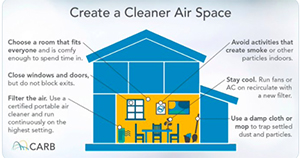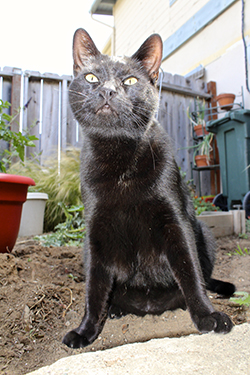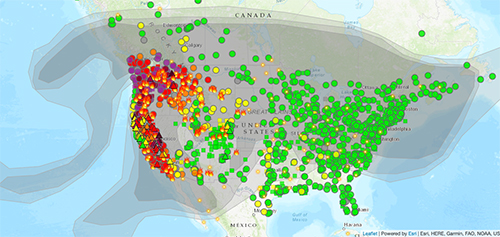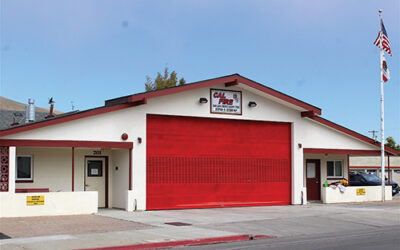A map from AirNow.gov shows the air quality ratings and the smoke plume across the United States on Sept. 15.
The smell of smoke in the air and hazy skies has become somewhat commonplace lately as a result of multiple wildfires blazing throughout California and parts of the Pacific Northwest. The impact on local air quality can change every day and even throughout the day.
“The past month in general we have experienced some of the worst air pollution was have seen in our area in some time,” said APCD Air Quality Specialist Meghan Field. “Morro Bay this week [beginning Sept. 13] experienced Very Unhealthy (purple on the AQI scale) on Monday and today moved into the Unhealthy (red) category. So while we are seeing some improvement, and expect to see more improvement this week, we are still being impacted from smoke from wildfires outside of our county.”
The negative impacts on local air quality will likely continue with the potential for a prolonged wildfire season, which, according to the Cal Fire website, is estimated to have increased by 75 days across the Sierras and seems to correspond with an increase in the extent of forest fires across the state.”
As of Sept. 22, the website lists 7,982 fires, 3,627,010 acres burned, 25 fatalities and 7101 structures destroyed so far this year. This year’s acres burned is 26 times higher than the acres burned in 2019 for the same time period.
Wildfires produce a range of harmful air pollutants, from known cancer-causing substances to tiny particles that can aggravate existing health problems and increase the risk of heart attack or stroke.
APCD Recommendations
The APCD recommends checking its website at https://www.slocleanair.org/air-quality/air-forecasting-map.php daily to be aware of local conditions.
“On that website we have current conditions at our monitoring stations across the county as well as forecasted conditions for a 6 day period so people can see what we expect the week to hold,” Field said. “Its important to remember though that smoke plumes can be unpredictable and can change rapidly, so it is important to check conditions regularly. When there are significant air quality events going on too, we keep our social media followers up to date as much as possible too. Lastly, we have a great resource called our AirAware text notification system. People can sign up to get alerts for various items, one being smoke impacts and the other being unhealthy air quality at https://www.slocleanair.org/air-quality-alerts.php.”
Generally, if you smell smoke or ash is visible in the air, County APCD officials recommend all adults and children avoid strenuous outdoor activity, remain indoors as much as possible, and set any heating/air conditioning/ventilation systems to recirculation. The public is advised to consult your doctor if you are experiencing health problems.
Very sensitive individuals such as infants, as well as children and adults with existing respiratory or heart conditions may experience adverse health effects on days that are orange on the color-coded map.
It is recommended that you avoid ash cleanup on cars and other materials until conditions improve. If you have to clean up ash, the following is recommended:
Use a damp cloth and spray areas lightly with water, take your vehicle to the car wash; wash off toys that have been outside in the ash; clean ash off pets; due to the corrosive nature of ash, avoid any skin contact with the ash (wear gloves, long-sleeved shirts); and do not use leaf blowers.

Cloth masks will not adequately protect you from inhaling wildfire smoke. During the COVID-19 pandemic, cloth masks are encouraged to protect others from the liquid droplets that are expelled when we speak, cough or sneeze from going into the air. Residual spray when you speak produces larger droplets than the PM2.5 particles produced during wildfire events.
For a list of links to find out more information online, go to https://bit.ly/3hJP9Gv
Pets and Wildfire Smoke

Photo by Theresa-Marie Wilson
Your pets can be affected by wildfire smoke. If you feel the effects of smoke, they probably do, too!
Smoke can irritate your pet’s eyes and respiratory tract. Animals with heart or lung disease and older pets are especially at risk from smoke and should be closely watched during all periods of poor air quality.
The EPA provides this information:
Smoke can irritate your pet’s eyes and respiratory tract. Animals with heart or lung disease and older pets are especially at risk from smoke and should be closely watched during all periods of poor air quality.
• Coughing or gagging
• Red watery eyes, nasal discharge, inflammation of throat or mouth or reluctance to eat hard foods
• Trouble breathing, including open-mouth breathing, more noise when breathing
• Fatigue or weakness, disorientation, uneven gait, stumbling
• Reduced appetite or thirst
Recommended Actions
When smoke is present:
Keep pets indoors as much as you can, with doors and windows closed. Bring outdoor pets into a room with good ventilation.
Smoke is especially tough on birds. Keep them inside when smoke is present.
Keep indoor air clean: do not fry or broil foods, vacuum, burn candles, use a fireplace or woodstove, or smoke tobacco products. These activities add particles to your home.
Spend less time outdoors and limit physical activities when it is smoky. For example, when it’s smoky, it’s not a good time for you and your pet to go for a run. Let dogs and cats outside only for brief bathroom breaks if air quality alerts are in effect.
Be ready to evacuate: Include your pets in your planning. Have each pet permanently identified, for example with a microchip. Know where they will be allowed to go if there is an evacuation – not all emergency shelters accept pets. Know where your pets might hide when stressed, so you won’t have to spend time looking for them in an emergency. Get pets used to their carriers and have your family practice evacuating with your pets. Covering carriers with a sheet during transport may calm a nervous pet.
If you must leave your pet behind, never tie them up.
Get more tips and information on caring for pets and livestock during wildfires via the American Veterinary Medical Association.



